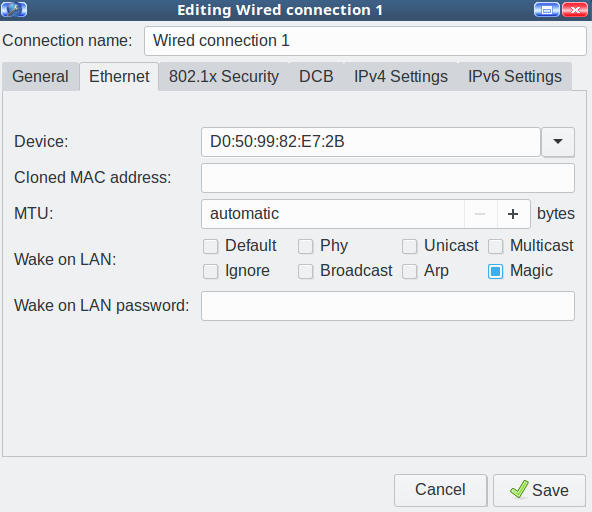Unfortunately the only thing I can find in the manual is the setting regarding wakeup by pcie. All powersaving modes are also turned off, the bios updates list mostly new cpu support and I feel like updating might be a risk since the amd 2400g is not officially supported on the newer versions (though I'm already running one of the more recent versions since I got the board) – yusisushi Nov. The target computer's motherboard and Network Interface Controller have to support Wake-on-LAN. The target computer has to be physically connected (with a cable) to a router or to the source computer for WoL to work properly. Some wireless cards have support for Wake on Wireless (WoWLAN or WoW). Supports Wake-on: pumbg. Current message level: 0x00000007 (7) drv probe link. Link detected: no. All forum topics. Configuring Wake-on-LAN is a simple process on Alpine Linux. First, check if your network card supports Wake-on-LAN (WOL): # apk add ethtool # ethtool eth0 grep -i wake Supports Wake-on: pumbg Wake-on: d Supports Wake-on: pumbg means that WOL is supported, Wake-on: d means that it is currently. Supports Wake-on: pumbg WOL is supported by your ethernet card, but for new machines this is alwatys the case. Now if you see the line; For the link I gave, you have ethertool and the status was plumbg; so WOL should be good to go at that point.
- Supports Wake On Lan Pumbg
- Proxmox 6 Wake On Lan
- Supports Wake On Pumbg
- Supports Wake-on D
- Wake On Lan Debian
I had a laptop at home that I didn’t really use much. I realized that I could save some power if I only power it on only when I need it.
Wake On LAN
Supports Wake On Lan Pumbg

I remember that I can use Wake On LAN (WOL) to power on a machine over the network, only if the NIC supports that. I checked out the model of the old machine:
Then after checking out the specs of the laptop luckily it had this option available. So I enabled that in the BIOS:
Proxmox 6 Wake On Lan
WOL NIC Support

Then after I powered it on, I confirmed it’s enabled on the NIC:
We can see the Supports Wake-on and Wake-on options are set appropriately.
Using a WOL Client to the Send Magic Packet
I figure out what the MAC address is:

Supports Wake On Pumbg
Then I just powered off the machine:
Then on my mac, I went ahead and installed the WOL client:
Then I went ahead and sent the magic packet:
Supports Wake-on D
and I kept a ping going and after some time the machine booted up:
Wake On Lan Debian
On my CentOS machine I just ended using ether-wake which is part of thenet-tools rpm:
And executing the following accomplished the same thing:
WOL Over a Router
I was running the command from machines that were on the same subnet as thedestination host. If you are traversing a switch or a router make sure those devices support passing the magic packet across and allow directed broadcasts.Here are some nice steps laid outfor dd-wrt. I will stick with local subnets :)
